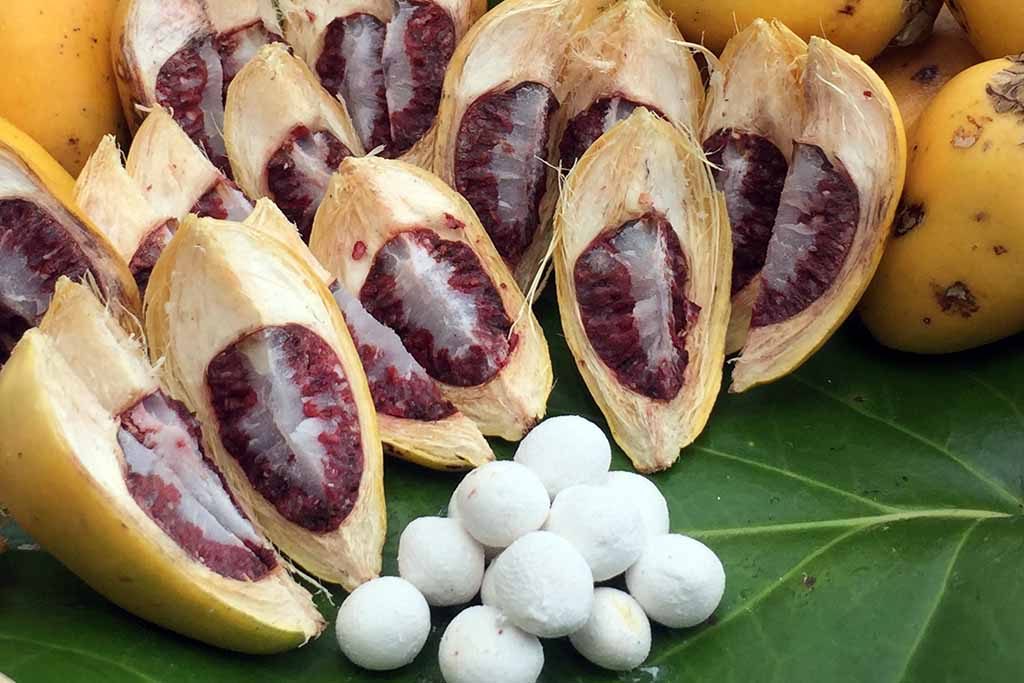Mamaisen Saina: Marriage Rituals

Second meeting
In ancient times in the Mariana Islands, three or four days before a wedding the relatives on both sides worked together to beat and clean the rice, which they then ground and mixed with young coconut (månha) into a dish called laulau. On the day before the marriage the female relatives prepared breadfruit, roots, and fish, while the men gathered wood and constructed a temporary shelter for the ceremony.
More recently, this meeting was noted by Concepcion Fejeran Garrido to be a bit more complex.
Once the families of the bride and groom agreed to their marriage (magutos I finio) the adults of the families had a serious meeting together. The bride and groom were not present.
A representative of the family would speak on their behalf. The groom’s parents would have assembled a bundle of items (balutan) that were gifts and a means of conversation between the two parties. They would put their best betel nut, betel nut leaves, tobacco and lime in the bundle. Some of the betel nut was cut up for the bride’s family to taste and the rest did not have the husk removed so that it could be saved for later. These items were put into a sack, which was similar to the cloth used for rice bags.
A woven mat was placed on the floor with the bundle in the middle. Both families sat on separate sides of the bundle. The groom’s representative started the scripted conversation by saying, “Faisen fan si balutan hafa malago’na?” (Ask the balutan what it wants). The balutan was a means for the two parties to speak indirectly to one another.
The bride’s representatives then asked the balutan what it wants by saying, “Håfa balutan, malago’mu?” The bride’s family then opened the balutan and said, “Pues ta baba ya ta puga’, ya ti ta fan makpo’ pa’go esta agupa’.” (We will open it and we will open it wide and we won’t be finished until tomorrow.)
The group acknowledged by this statement that it was expected to be a long and difficult process to get married.
Now that the discussion had been formally opened, the groom’s family had to stay at the bride’s house and adhere to whatever the bride’s family wanted. They committed to staying until the bride’s family agreed about the particulars of the wedding ceremony.
Every statement in this formal ceremony was made to rhyme and sound poetic.
After opening the bundle, the bride’s representatives then presented the betel nut and the betel nut leaves and said, “Pugua’, pugua’, ni pa’go chinafi. Pupulu, pupulu, ni ma chalakki.” They complimented the betel nut because it was ripe and did not stay too long on the tree. They complimented the leaves because they were spread out nicely in a bunch. They then picked up the tobacco and the lime and said, “Amuska, amuska, ni ma filak ya ma fa’ pasta. Afok, afok, ni ginen i acho. Este hit u chule’, yan este hit u atu.” They complimented the tobacco because it was nicely braided and sweet. They said that the lime was made from rock, or limestone. The bride’s family ended by indirectly saying that this offering was accepted for their daughter.
After the bride’s family had complimented the gifts, the two families then chewed together (mamå’on). During the formal request, the groom’s parents explained that their intentions for meeting with them were to ask that their son have the couple’s daughter’s hand in marriage. After much consideration, the bride’s family agreed and the couple had their parent’s blessings. A date was set for the next meeting. The groom’s family agreed to the date that was most convenient for the bride’s family.
After the mamaisen saina, the groom’s family asked the bride’s family if they could see their bride-to-be. The girl was invited to come out into the main room. The groom’s family would say, “Ai na buniton mata, ai na buniton pachot, ai na buniton fasu. Ai na buniton pachot esta karambot karachot.” (Such pretty eyes, such attractive nose, smooth face and a beautiful mouth.)
The groom’s family thanked the bride’s parents for meeting with them and for granting their son permission to marry the young woman and left the house. Their next meeting would be to plan the wedding. (Magutos i Finihu’/Rebirensia).
This CHamoru tradition is no longer seen on Guam.
For further reading
Bailey, C.R. Kim. “Chamorrita Songs: A Surviving Legacy of the Mexican Verso?” Paper presented at the 26th Annual Meeting of the Society for Ethnomusicology, Honolulu, HI, October 1981.
Cunningham, Lawrence J. “Pre-Christian Chamorro Courtship and Marriage Practices Clash with Jesuit Teaching.” In Guam History: Perspectives. Volume Two. Edited by Lee D. Carter, William L. Wuerch, and Rosa Roberto Carter. Mangilao: Richard F. Taitano Micronesian Area Research Center, University of Guam, 2005.
Flores, Judy, ed. Kustumbren Chamoru: Chamorro Life Before and After World War II. A Collection of Oral Histories by Students of History of Guam Classes. Mangilao: University of Guam, 2004.
Freycinet, Louis Claude Desaulses de. An Account of the Corvette L’Uraine’s Sojourn at the Mariana Islands, 1819. Translated by Glynn Barratt. Saipan: Commonwealth of the Northern Mariana Islands Division of Historic Preservation, 2003.
Guam Council on the Arts and Humanities Agency. “Chamorro Courtship and Marriage Practices in the Early 1900’s.” A collection of stories from the Chamorro Courtship and Marriage Conference, Maite, Guam, November 1989.
Howard, Chris Perez. Edward: An American Tragedy. Hagåtña: Cyfred, Ltd, 2000.
Iyechad, Lilli Perez. An Historical Perspective of Helping Practices Associated with Birth, Marriage and Death Among Chamorros in Guam. Lewiston: Edwin Mellen Press, 2001.